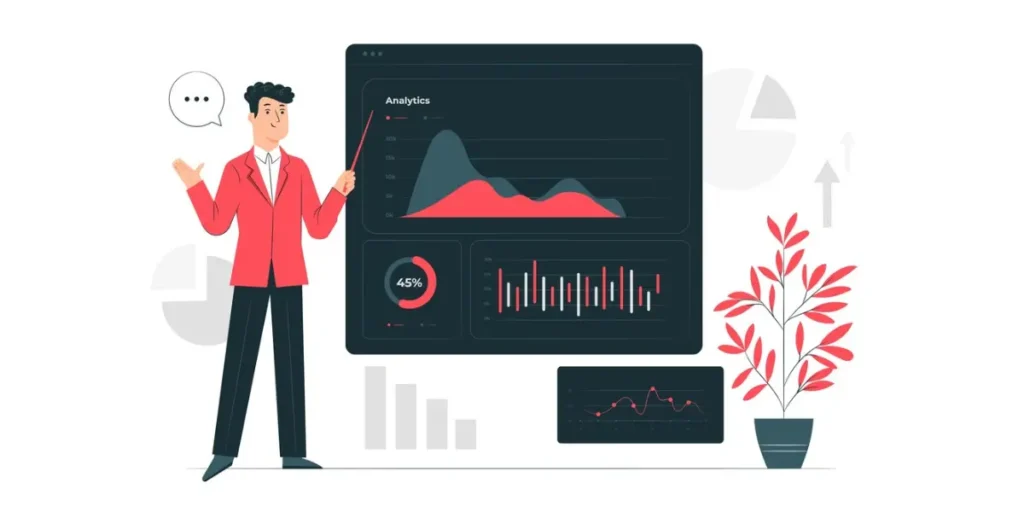When it comes to captivating your audience, QRs are the unsung heroes of the digital realm. Let’s kick it up a notch – it’s not just about slapping together a code anymore. It’s about diving deep into data, understanding your audience, and maximizing every interaction.
Cue the drumroll for our latest innovation: the QR Code Generator with Analytics.
Picture this: you’re not just creating QRs; you’re unraveling insights, decoding behaviors, and unleashing a tsunami of engagement like never before. It’s not just about being seen; it’s about being heard, understood, and remembered.
In this blog, we’re diving headfirst into QRs with a twist – analytics that packs a punch. From unraveling the mysteries of audience engagement to turning clicks into conversions, we’re giving you the playbook for digital domination.
So, buckle up, because we’re about to embark on a journey that will transform the way you think about QRs forever. Prepare to revolutionize your digital strategy and leave your competition in the dust.
A. Importance of analytics in QR Code usage

1. Insight into audience behavior
Analytics offer valuable data on scan rates, timing, and location, providing insights into how, when, and where QR Codes are being engaged with.
2. Real-time optimization
Armed with data-driven insights, marketers can adjust QR Code campaigns on the fly, optimizing placement, design, and content for maximum impact.
3. Conversion tracking
By integrating analytics, marketers can track the entire user journey from scan to conversion, whether it’s driving website traffic, capturing leads, or boosting sales.
4. Measurable ROI
Analytics enable marketers to quantify the effectiveness of QR Code campaigns, allowing for informed decision-making and ensuring a solid return on investment.
5. Enhanced strategy
With a deep understanding of audience preferences and behaviors, marketers can refine their QR Code strategy, delivering more relevant and engaging experiences to their target audience.
B. How QR Code analytics can enhance marketing strategies

Certainly! Here’s how QR Code analytics can enhance marketing strategies:
1. Data-driven insights
QR Code analytics provide valuable data on user interactions, including scan rates, time of engagement, and geographic location. These insights offer marketers a deeper understanding of their audience’s behavior and preferences.
2. Optimized campaigns
Armed with analytics, marketers can refine and optimize their QR Code campaigns in real-time. By analyzing which QR Codes are performing well and which aren’t, they can make data-driven decisions to improve campaign effectiveness.
3. Personalized experiences
Understanding user behavior through analytics allows marketers to create more personalized experiences. By tailoring QR Code content based on user preferences, marketers can increase engagement and drive conversions.
4. A/B testing
QR Code analytics enable marketers to conduct A/B testing to determine which elements of their campaigns resonate best with their audience. By testing different QR Code designs, placements, and call-to-actions, marketers can identify the most effective strategies for driving engagement.
5. Tracking ROI
With analytics, marketers can track the ROI of their QR Code campaigns more accurately. By measuring metrics such as conversions and revenue generated, marketers can demonstrate the impact of their campaigns and allocate resources more effectively.
6. Integration with marketing stack
Many QR Code analytics platforms offer integrations with popular marketing tools such as CRM systems and email marketing platforms. This seamless integration allows marketers to incorporate QR Code data into their existing workflows, streamlining campaign management and analysis.
7. Iterative improvement
By continuously monitoring and analyzing QR Code analytics, marketers can identify areas for improvement and iterate on their campaigns over time. This iterative approach allows marketers to stay agile and adapt to changing consumer preferences and market conditions.
Generate a QR Code For Your Unique Case
START TODAY!
C. Choosing the right QR Code generator with analytics feature

Selecting the right QR generator with analytics features is crucial for maximizing the effectiveness of your marketing campaigns.
Here are some key considerations to help you make an informed decision:
1. Comprehensive analytics
Look for a QR Code generator that offers robust analytics capabilities. This includes metrics such as scan rates, location data, time of engagement, device type, and more. The more comprehensive the analytics, the better insights you’ll have into your audience’s behavior.
2. Real-time reporting
Choose a QR Code generator that provides real-time reporting capabilities. This allows you to monitor the performance of your QR Code campaigns as they unfold and make immediate adjustments if needed.
3. Customization options
Opt for a QR Code generator that offers customization options for your QR Codes. This includes the ability to add your logo, change colors, and customize the design to align with your brand identity. Customizable QR Codes not only look more professional but also help increase brand recognition.
4. Integration with marketing tools
Consider a QR Code generator that integrates seamlessly with your existing marketing tools and platforms. This includes CRM systems, email marketing software, analytics platforms, and more. Integration ensures that you can easily incorporate QR Code data into your overall marketing strategy and workflow.
5. Security features
Security is paramount when dealing with QR Codes, especially if they contain sensitive information or link to secure websites. Choose a QR Code generator that prioritizes security and offers features such as password protection, expiration dates, and encryption to safeguard your data.
6. Ease of use
Look for a QR Code generator that is user-friendly and intuitive to use. This includes features such as drag-and-drop functionality, customizable templates, and a simple interface that makes it easy to create and manage QR Codes without any technical expertise.
7. Affordability
Consider the pricing structure of the QR Code generator, including any subscription fees or per-code charges. Choose a solution that offers transparent pricing and provides good value for money based on your budget and requirements.
8. Customer support
Lastly, consider the level of customer support provided by the QR Code generator. Look for a provider that offers responsive customer support via email, phone, or live chat, as well as comprehensive documentation and resources to help you get the most out of the platform.
D. Analyzing QR Code performance metrics: What to look for

Analyzing QR performance metrics is essential for understanding the effectiveness of your campaigns and optimizing future strategies.
Here’s what to look for when evaluating QR Code performance metrics:
1. Scan rate
The scan rate measures the number of times your QR Code has been scanned. It provides an overall indication of campaign reach and engagement.
2. Location data
Analyzing where your QR Codes are being scanned can provide valuable insights into your target audience’s geographic distribution and behavior patterns.
3. Time of scan
Understanding when your QR Codes are being scanned can help you identify peak engagement times and tailor your campaigns accordingly.
4. Device type
Analyzing the types of devices used to scan your QR Codes (e.g., smartphones, tablets) can inform your mobile optimization strategies and user experience design.
5. Conversion rate
Tracking the number of scans that result in desired actions, such as website visits, form submissions, or purchases, helps measure campaign effectiveness and ROI.
6. Engagement path
Examining the user journey post-scan, including the pages visited and actions taken, provides insights into user behavior and preferences.
7. Error rate
Monitoring the frequency of scanning errors, such as invalid URLs or inaccessible content, helps identify potential issues and optimize QR Code design and implementation.
8. Retention rate
Assessing how frequently users return to scan the same QR Code can indicate campaign longevity and audience interest over time.
9. Demographic data
If available, demographic information such as age, gender, and interests of QR Code scanners can inform targeted marketing strategies and audience segmentation.
10. A/B testing results
Conducting A/B tests with different QR Code designs, placements, or call-to-actions allows you to identify the most effective variations and optimize future campaigns.
11. Cost per scan
Calculating the cost per scan by dividing the total campaign cost by the number of scans provides insights into campaign efficiency and cost-effectiveness.
E. Real-world applications of QR Code analytics

QR Code analytics offer valuable insights that can be applied across various industries and use cases. Here are some real-world applications of QR Code analytics:
1. Retail and e-commerce
Retailers can use QR Code analytics to track customer engagement with product information, promotions, and loyalty programs. By analyzing scan rates, conversion rates, and demographic data, retailers can tailor their marketing efforts, optimize product placements, and personalize the shopping experience.
2. Marketing campaigns
Marketers can leverage QR Code analytics to measure the effectiveness of their campaigns across various channels, such as print ads, posters, and direct mail. By tracking scan rates, engagement paths, and conversion rates, marketers can identify which channels and messaging resonate most with their target audience and allocate resources accordingly.
3. Event management
Event organizers can use QR Codes to streamline attendee registration, provide access to event materials and resources, and facilitate networking opportunities. By analyzing scan data, event organizers can track attendance, measure session popularity, and gather feedback to improve future events.
4. Hospitality and tourism
Hotels, resorts, and tourist attractions can use QR Codes to enhance guest experiences by providing access to digital maps, audio guides, and exclusive offers. By analyzing scan data, hospitality businesses can gain insights into guest preferences, track engagement with amenities and services, and tailor personalized recommendations to enhance guest satisfaction.
5. Education and training
Educators and trainers can use QR Codes to deliver supplementary materials, quizzes, and interactive content to students and learners. By analyzing scan data, educators can track student engagement, identify areas for improvement, and assess the effectiveness of instructional materials and activities.
6. Healthcare and pharmaceuticals
Healthcare providers and pharmaceutical companies can use QR Codes to provide patients with access to medical information, appointment scheduling, and prescription refills. By analyzing scan data, healthcare organizations can track patient engagement with educational resources, monitor medication adherence, and improve communication between patients and providers.
7. Supply chain management
Manufacturers, distributors, and logistics companies can use QR Codes to track inventory, monitor shipments, and streamline supply chain operations. By analyzing scan data, organizations can track product movement, identify bottlenecks, and optimize inventory levels to improve supply chain efficiency and reduce costs.
8. Emergency response and public safety
Government agencies and emergency responders can use QR Codes to provide access to critical information during emergencies, such as evacuation routes, shelter locations, and safety instructions. By analyzing scan data, emergency management agencies can assess the effectiveness of public awareness campaigns, monitor community response, and improve preparedness efforts.
Overall, QR Code analytics offer valuable insights that can be applied across a wide range of industries and use cases to enhance customer engagement, improve operational efficiency, and drive business success.’
F. Tips for maximizing the effectiveness of QR Code generator with analytics

Maximizing the effectiveness of QR Codes with analytics requires a strategic approach and attention to detail.
Here are some tips to help you get the most out of your QR Code campaigns:
1. Set clear objectives
Define specific goals for your QR Code campaigns, such as driving website traffic, generating leads, or increasing sales. Align your analytics metrics with these objectives to measure success accurately.
2. Design engaging QR Codes
Create visually appealing QR Codes that stand out and entice users to scan them. Incorporate your brand logo, colors, and imagery to make your QR Codes more recognizable and memorable.
3. Provide value-added content
Offer valuable incentives or content to users who scan your QR Codes, such as exclusive discounts, product information, or educational resources. Ensure that the content is relevant, informative, and easily accessible.
4. Optimize placement and visibility
Strategically place your QR Codes in high-traffic areas where your target audience is likely to encounter them, such as storefronts, packaging, or marketing materials. Ensure that the QR Codes are large enough to scan easily and are not obscured by other visual elements.
5. Track and analyze performance
Monitor key metrics such as scan rates, conversion rates, and engagement paths using your QR Code analytics dashboard. Regularly review the data to identify trends, patterns, and areas for improvement.
6. Iterate and improve
Use insights from your QR Code analytics to iterate and optimize your campaigns over time. Test different QR Code designs, placements, and call-to-actions to identify the most effective strategies for driving engagement and conversions.
7. Integrate with other marketing channels
Incorporate QR Codes into your broader marketing strategy and integrate them with other channels, such as social media, email marketing, and print advertising. Use QR Code analytics to track cross-channel engagement and measure the impact of your integrated campaigns.
8. Ensure data privacy and security
Protect user data and ensure compliance with data privacy regulations by implementing security measures such as encryption, authentication, and data anonymization. Be transparent about how you collect, store, and use QR Code data and obtain user consent where necessary.
9. Stay up to date with trends
Keep abreast of emerging trends and best practices in QR Code marketing and analytics. Experiment with new technologies, formats, and strategies to stay ahead of the curve and maintain relevance with your audience.
Summing Up
The integration of analytics with QR Code generation is more than just a convenience – it’s a game-changer.
From unraveling insights into audience behavior to fine-tuning campaign strategies in real time, the possibilities are endless.
If you’re still reading, you’ve learned everything about QR Code generator with analytics. If you have any questions, let us know in the comments.
Always go for a reputed QR Code service provider
Generate a QR Code For Your Unique Case
START TODAY!
